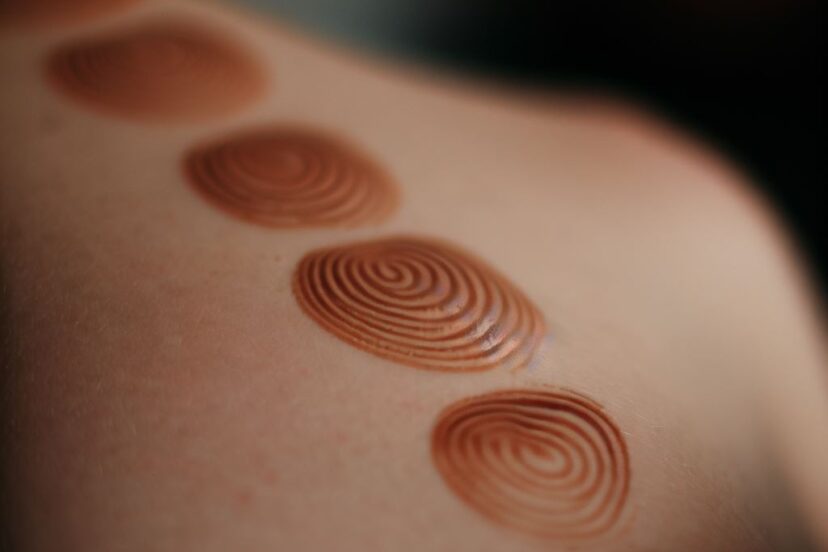Cupping Marks Explained: Unraveling the Mystery
*We may earn a commission for purchases made using our links. Please see our disclosure to learn more.
Cupping Marks Explained: Understanding the Science and Effects
Cupping therapy is an ancient form of alternative medicine that involves placing cups on the skin to create suction. But what exactly to the marks mean after treatment mean? Let’s jump into Cupping Marks Explained! As a wellness advocate, I’ve observed that this technique is not only rooted in traditional practices, but has also gained modern recognition for its potential therapeutic effects. Patients often seek cupping therapy for relief from various ailments including back pain, neck pain, headaches, and other physical discomforts.

One of the most notable effects of cupping therapy is the appearance of marks on the skin. These discolorations are similar to bruises and are caused by broken blood vessels beneath the skin due to the suction effect. In my experience, the presence of these cupping marks is often seen as an indication of the treatment’s impact on areas where there is blood and Qi stagnation, accumulation of toxins, or dampness in the body.
While some may be concerned about these marks, I reassure my patients that they are a normal side effect and typically resolve on their own. The color and pattern of the cupping marks can sometimes provide insights into the patient’s condition, reflecting the level of stagnation and the body’s response to the therapy. It is essential to inform patients that, while the visual evidence of cupping can seem alarming, it is generally a safe practice when performed by a trained professional, with minimal risks involved.
The Basics of Cupping Therapy

In my practice, I utilize cupping therapy as a form of alternative medicine where suction is created on the skin to promote healing and improve blood flow. This traditional technique has deep roots in healthcare practices across the world.
Understanding Cupping and Its Histories
Cupping therapy is a healing method that I’ve learned has been used for thousands of years, with roots in Traditional Chinese Medicine. The primary goal of cupping is to improve the circulation of qi—the life force or energy flow that practitioners believe is essential for overall well-being. Historically, cups were made from natural materials like bamboo; nowadays, I have the option to use glass cups, silicone cups, or cups that create a vacuum to induce suction.
Types of Cupping: Dry and Wet
There are two main types of cupping techniques that I’ve come across: dry and wet cupping.
- Dry Cupping: This form involves placing a cup on the skin and then creating suction by heating the air inside the cup or using a mechanical pump. The vacuum created by the cooling air or the pump draws the skin upwards and allows for the targeted area to receive an increase in blood flow.
- Wet Cupping: Wet cupping, which I have observed is slightly more invasive, involves a similar suction process. However, before applying the cup, a small incision is made on the skin to draw a small quantity of blood out during the suction. This type is believed to remove harmful substances and toxins from the body.
Both methods are reputed to aid in providing relief for a variety of ailments, including pain and inflammation. When considering the use of cupping therapy, it is essential that I ensure it is performed by a trained professional to minimize risks such as bruising or skin infection.
The Science Behind Cupping

In exploring the science behind cupping, I will examine how the practice of cupping relies on specific principles to achieve its effects on the body, particularly relating to blood flow and muscle tension.
Principles of Suction and Pressure of Cupping Marks Explained
Cupping therapy utilizes suction to lift the skin and superficial muscle layers as cups are placed onto targeted areas of the body. I understand this action creates a negative pressure environment within the cup, contrasting with the positive pressure of the surrounding atmosphere. The key here is the contrast in pressure, as it promotes the expansion of the underlying tissues. This aspect of cupping is critical in understanding its potential therapeutic effects.
Cupping Marks Explained: Effects on Blood Flow and Muscle Tension
By creating a suction effect, cupping can increase blood circulation to the area where the cups are applied. Enhanced circulation can result in a cascade of effects such as the nourishment of muscles and skin, leading to a potential reduction in muscle tension. My knowledge indicates that the deliberate application of negative pressure facilitates the drawing of fresh blood to those areas, which may assist in the healing process. Furthermore, the stimulation provided by the suction is also believed to possibly ease pain by releasing endorphins and promoting the relaxation of tight muscles.
When considering the science of cupping, it’s essential to understand that while many individuals report relief from various symptoms, the mechanisms of how cupping may influence healing and pain reduction are still being investigated in the scientific community.
Cupping Therapy Applications

In my experience, cupping is diverse in its applications, particularly favored by athletes for managing physical ailments and by those seeking a gentler approach to skin health through facial cupping.
Cupping for Athletes and Physical Ailments
Athletes frequently turn to cupping therapy to address back pain, neck pain, and sore muscles. The suction created by the cups promotes increased blood flow, which aids in the recovery process and pain reduction. This method is often used to:
- Address specific pain points: Focusing on areas affected by sports injuries or strain
- Support overall muscle health: Aiding in the maintenance of muscle flexibility and recovery after intense activities
Specific conditions like arthritis and migraines can also be managed through cupping, providing athletes and active individuals with an additional, non-invasive treatment option.
Facial Cupping and Its Unique Approach
Facial cupping sets itself apart with the use of small, specially designed cups that are meant for the delicate skin on the face. The key aims of facial cupping include:
- Enhancing skin rejuvenation: By increasing blood flow, it helps to promote a healthy glow.
- Detoxifying the skin: The gentle suction encourages lymphatic drainage, which can remove toxins from the skin.
Facial cupping is approached with great care to avoid leaving marks, and although it’s different from body cupping, it still retains the core principle of using suction to improve health and wellness.
Potential Risks and Side Effects

In my expertise, I can confirm that cupping therapy, while offering various health benefits, also presents certain risks and side effects, predominantly in the form of discomfort, cupping marks, and the potential for skin infections.
Navigating through Discomfort and Marks
Discomfort can be a side effect of cupping therapy. The sensation is typically a result of the suction process, which, although it can ease muscle tension, might cause feelings of pressure or minor pain during the session.
- Bruises and Bruising: It’s not uncommon for patients to experience bruising after cupping. This discoloration is due to blood vessels reacting to the suction effect.
- Mild Bruising: Usually appears as light purple or red spots that fade over time.
- Significant Bruising: Darker and more noticeable marks that may take longer to heal and could cause more discomfort.
- Cupping Marks: The trademarks of the therapy are temporary skin discoloration marks that appear where the cups are applied.
- Color and Duration: The marks can range from light red to deep purple, typically fading within a few days to a couple of weeks.
Cupping Marks Explained: Recognizing and Preventing Infections
Infections can occur post-cupping, particularly if the equipment isn’t sterilized correctly or if the patient’s skin integrity is compromised.
- Preventing Infections: Ensuring proper hygiene and sterilization techniques are critical to preventing infections.
- Equipment Sterilization: Cups and any related therapy tools must be thoroughly cleaned to eliminate bacteria.
- Skin Care Post-Procedure: I advise patients to keep the area clean and dry, and to follow any specific aftercare instructions provided.
- Risk Factors for Infections: Certain pre-existing skin conditions can elevate the risk.
- Eczema and Psoriasis: Patients with these conditions should approach cupping with caution, as they are more prone to post-therapy infections.
Mindful of side effects and risks, patients can safely engage in cupping therapy by following proper preventative measures.
Aftercare and Long-Term Benefits

Cupping therapy leaves distinctive marks, often confused with bruises, which are a normal part of the healing process. Proper aftercare can optimize the healing process and enhance the long-term wellness benefits such as relaxation and pain relief.
Understanding the Healing Process
I notice that after cupping therapy, the marks appear as red to purple suction marks on the skin. These marks aren’t bruises; they’re temporary and show that the treatment has stimulated my lymphatic system, promoting healing. Usually, these cupping therapy marks last anywhere from a few days up to a couple of weeks. Despite their appearance, they are typically painless.
To support the healing process, I follow specific aftercare steps:
- I keep the area clean, gently washing with a mild soap to prevent any risk of infection.
- I stay well-hydrated, aiding my body’s natural detoxification and recovery process.
Lifestyle and Wellness Enhancement and Cupping Marks Explained
Cupping therapy, beyond immediate relief, offers long-term wellness benefits through repeated sessions. This ancient therapy aids in relaxation and pain relief, which can help reduce chronic stress and muscular tension.
For lasting benefits, I integrate cupping into my lifestyle using the following practices:
- Consistent Sessions: Regular appointments maintain the wellness benefits.
- Balanced Activity: Post-therapy, I avoid strenuous exercise for 24 hours but engage in light activities like yoga to maintain movement and flexibility.
Understanding the healing process makes cupping a valuable addition to my health routine and lifestyle.
Professional Practice of Cupping
In the professional practice of cupping, it’s crucial to navigate between well-established procedures and the latest research findings. I emphasize choosing a trained therapist and recognizing research and clinical studies in developing cupping therapy.
Selecting a Qualified Therapist
When seeking cupping therapy, I ensure the therapist is credentialed and skilled. Professional athletes and individuals should look for therapists who are:
- Licensed healthcare professionals: This may include acupuncturists or massage therapists with additional training in cupping.
- Certified in cupping therapy: Certification ensures they have received proper training and are up to date with safety procedures.
The Role of Research and Studies
I hold that research and clinical studies are integral to validating the benefits and optimizing the safety of cupping therapy. While the evidence is growing, here’s what is currently understood:
- Research: There are a number of studies investigating cupping’s efficacy, indicating potential benefits for pain, inflammation, and certain health conditions.
- Medical advice: Always consider medical advice when integrating cupping into a health regimen, as research alone cannot account for individual health needs.
Frequently Asked Questions
In this section, I’ll answer some of the most common inquiries regarding what cupping marks reveal about one’s health. Each color and pattern can provide valuable information about the body’s condition.
1. What do the different colors of cupping marks indicate about your health?
Lighter shades generally suggest minimal toxin presence, while darker shades may indicate more significant stagnation or blood flow issues.
2. How long do cupping marks typically last?
Cupping marks usually fade within a few days to a week, varying by individual. The longevity of these marks can also depend on the individual’s skin type and overall health.
3. Can the severity of stagnation be determined from cupping marks?
The color, pattern, and duration of cupping marks can give insights into the level of blood and qi stagnation. Deeper colors like dark purple often suggest a higher degree of stagnation within the body.
4. What factors could lead to not having marks after a cupping session?
No marks after cupping can be due to the technique, skin and blood vessel response, or lower tissue stagnation.
5. Is the presence of blood during a cupping session a normal occurrence?
Seeing blood in cupping is common, especially with skin puncturing techniques or areas with significant stagnation. This should always be conducted by a trained professional within a safe and hygienic setting.




